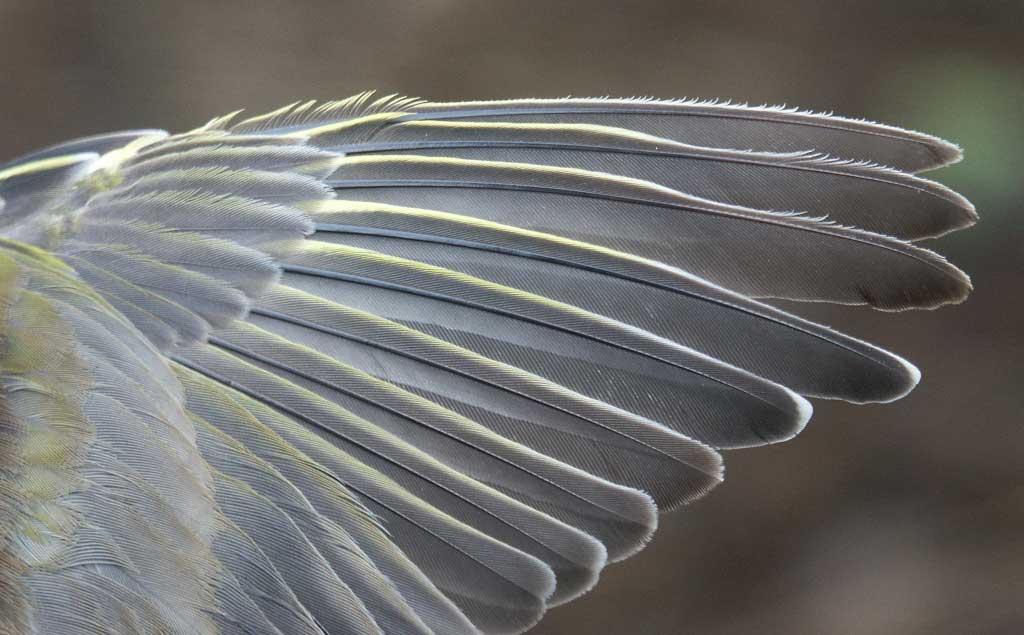Some interesting seed-eaters (West Burton Ringing Course) (24 November 2003)
None of these photographs was taken in MRG's area, but came from the very enjoyable and instructive ringing course based at West Burton, 20-23 November 2003; thanks to Adrian Blackburn and the North Nottinghamshire Ringing Group for their efforts in hosting the course.
A lot of Bramblings Fringilla montifringillawere caught, allowing us to admire their gorgeous tortoiseshell colours:

Almost all of the Bramblings ringed were first-year birds, so we could record the variation in extent of post-juvenile moult, especially the numbers of 'old greater coverts' (ogcs) retained from their juvenile plumage. Most had 3 or 4 'ogcs', as with these two males:


With the females, it can be somewhat trickier to distinguish the different generations of feathers, especially because the amount of orange colour decreases from one covert to the next, with the proximal (nearest to the body) being the most deeply coloured and the distal (away from the body) greater coverts appearing to be tipped mainly with white. Adult birds have more intense colours on all of the wing feathers, coverts and remiges, including the tertials (only the smallest tertial feather being visible in these photos). The shape of the primary coverts and alula feathers is also helpfully diagnostic. These photos compare the wings of two females, a first-year (Euring age code 3) and an adult (Euring age code 4):

Tail feather shape is often helpful, although - as with most finches - one has to beware of the occasional first-year bird that has moulted its tail. The adult female depicted above right had a classically rounded tail:

Brambling is another of the species that gains a distinctive head colour by abrasion during the winter: the buff tips on each feather obscure the black head colour of a breeding male bird. The lighter-coloured parts of the feather, lacking melanin, are physically weaker and wear faster, so that the head looks blacker as the winter progresses. This is nicely shown here, in top view and side view, for two different first-year male birds, and I have previously illustrated the same effect for male Chaffinches Fringilla coelebs.


Several other species gain their head coloration the same way: Reed Bunting Emberiza schoeniclus, Fieldfare Turdus pilaris and Siskin Carduelis spinus amongst those that we most frequently handle. All of these are flocking species, and camouflaging the head is probably an adaptation to reduce intra-specific aggression during the winter, whilst allowing birds to assume their breeding plumage without the energy expenditure of another moult.
One of the highlights of the West Burton ringing course was being able to handle substantial numbers of species of conservation concern, which attract a rebate to be paid for every bird ringed as a recognition of their special importance. After a couple of nights of frost, Yellowhammers Emberiza citrinella found one of the sites to their liking, and provided an interesting test in ageing and sexing. Jenni and Winkler (Moult and Ageing of European Passerines, 1994) state 'plumage characters difficult to apply': apparently all first-year birds moult all lesser, median and greater coverts, and moult limits are extremely difficult to see if they involve the carpal covert or alula. The head pattern, and tail shape and abrasion, are the main characteristics for ageing Yellowhammers.
There is a lot of variation in head plumage, this being another species that gains its breeding plumage by abrasion of the feather tips. In the composite photograph below, the left and central birds in the top row were adjudged to be males, with the other four females, but the range of variation is considerable:
.jpg)
The photo below shows a collection of tails from five birds. Those at top left and top centre are obvious first-year (age 3) tails, with the text-book pointed and abraded feathers, and that at top right is also a 3, although less worn than the first two. The bird at bottom left was at first thought to be an adult, but on careful inspection it can be seen to be a first-year bird that has moulted most of its tail, with only t3 and t4 (symmetrically) being juvenile feathers. The tail at bottom right is from an adult female. As well as the shape and wear, adult feathers show more extensive white on the outermost two (t5 and t6), although there is a lot of individual variation and also a sexual difference in this, as with the colour of the rump (uppertail coverts), the bird at bottom left being a male and bottom right a female.

The Tree Sparrow Passer montanus is the passerine species that has been hardest-hit in recent times, with its British breeding population dropping by 96% between 1968 and 1999 according to BTO censuses. Adults and first-year birds have a complete moult in the autumn and it is thus impossible to age them by plumage, like House Sparrow Passer domesticus.

Many more examples are now being found of first-year Greenfinches Carduelis chloris that have undertaken an aberrant moult, with some new primary feathers without the corresponding primary coverts. This seems mostly to be seen in males, but the bird shown below is a first-year female that has moulted primaries 5 and 6 - this being a fortunate example where I do not have to specify whether this feather numbering is ascendant or descendant - and the new feathers can readily be seen to have darker colour, with more intense yellow edging. They are much fresher than the other primary feathers, as most obviously seen by comparing the abrasion at the feather tips:

This bird has undergone an extensive autumn moult, including all three feathers of the alula, as seems to be the case for all that have moulted some primaries. According to Jenni and Winkler primaries 5 and 6 are by far the most commonly observed feathers for eccentric moult in Greenfinches (data in their Fig.32, p.36).
The subject of Greenfinch moult is covered extensively in other pages on this site.
David Norman.